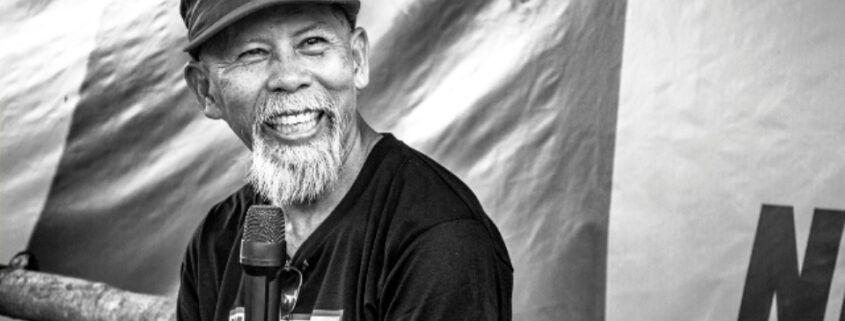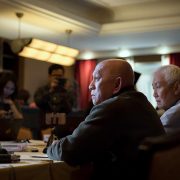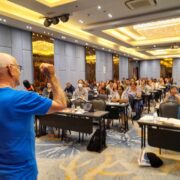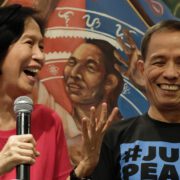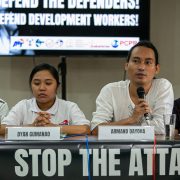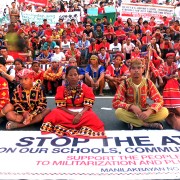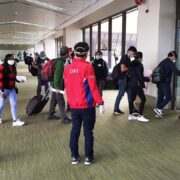One last question I wanted to ask Jorge ‘Ka Oris’ Madlos
By Raymund B. Villanueva
(The author has been covering the peace process between the NDFP and the GRP and has interviewed Jorge ‘Ka Oris’ Madlos on several occasions. Here is the journalist’s look-back on one of his most respected sources.)
He was inside a swidden hut that Christmas night I first laid eyes on Mindanao’s legendary rebel leader. An electric bulb was casting a wan glow on a makeshift porch and Jorge Madlos was wearing a stubby flashlight on his forehead as he furiously tapped on his laptop, seemingly unaware of the frenzied atmosphere around him. It was the eve of the Communist Party of the Philippines’s (CPP) 42nd founding anniversary and the then National Democratic Front of the Philippines (NDFP)-Mindanao spokesperson was busy polishing the statement he was to issue the next day.
His comrades directed us to a nearby creek to wash up, noticing our pants and shoes were caked with drying mud, victims of several spills on rice paddies and mud puddles on the way to the New People’s Army (NPA) encampment on Mt. Diwata’s foothills. Finding our way back to his hut, Madlos, more famous as Ka Oris, was done typing, beaming a toothy smile and waiting to finally welcome the new arrivals from the city.
“Maligayang pagdating. Salamat sa pagpunta. Kumusta ang biyahe?” Oris asked, eager to hear what we had to say in return. (Welcome. Thank you for coming. How was your trip?) His interest was understandable; we have been told he had a direct hand in organizing the trips. He had done so in the many decades that he welcomed to NPA camps journalists and many other kinds of visitors.
He invited us to dinner, a surprisingly sumptuous fare of adobo and lechon on heaps of piping hot fragrant mountain rice. “Are these the ones being cooked in the barrios we passed by?” we asked. “No. What the masses are cooking tonight will be brought to the celebrations tomorrow. December 26 is their real holiday,” he said. “These adobo and lechon are gifts from local politicians,” he added, laughing. Oris however had fish stew, a healthier meal to manage his urination problems brought about by a spine infection.
It was getting late and Oris held back on asking the many questions he was also known for. Journalists from all over trooped to where they could get hold of him, but he was equally famous for quizzing them in turn. “Baka pagod na kayo. Maaga tayo bukas. Doon sa may mangga ang pwesto niyo,” he said, pointing to where our tents were being put up. (You may already be tired. We have an early day tomorrow. Your tents are being put up under that mango tree.)
We almost never got the chance to have Oris to ourselves again the next day. Along with the thousands of attendees who descended on an open field were Mindanaoan reporters and national and international journalists there to cover the biggest story of the day and interview one of the country’s media darlings. Even journalists who were known to be critical of the communists were invited and welcomed.
During the celebrations, we witnessed firsthand how Oris was one of the journalists’ most beloved sources, especially by Mindanaoan reporters. He had ordered special spots for us to be able to take good photos of the NPA parade. He issued us press passes and badges that were proudly worn the entire day. He made the press conference part of the day long celebrations, fielding the seemingly never-ending stream of questions with dashes of wry humor. He repeatedly thanked the journalists who came, easily identifying which parts of Mindanao or elsewhere in the world they were from or writing for. He handed out “certificates of attendance,” accepted with much jollity and, I suspect, are being kept to this day. A “class picture” with the journalists capped our day, with Oris at the center, looking much like a grandfatherly school principal among wards. I very much doubt any Armed Forces of the Philippines (AFP) general went as famously with the journalists as the diminutive guerilla did.
Hard-nosed journalists emerge satisfied with every interview session with Oris. He was obviously naturally intelligent, conversant in at least four languages. Questions designed to trap him were deftly turned around, such as, “You have been waging this war for decades, yet you have failed to win,” to which Oris replied, “The much stronger government and imperialists could not defeat us either.” A correspondent of an international news wire agency asked, “Will it not be more difficult for the movement at this time, given that President Aquino is popular?” “He is not popular in our areas of control,” was Oris’ riposte.
The AFP was furious at the brazenness of the CPP celebrations that day that, despite the existence of ceasefire declarations, it put up checkpoints on the roads leading out of the area to harass attendees on their way home. The local Philippine Army (PA) battalion commander was in a towering rage, sources said, especially when a politician’s mindless aide delivered his donation of lechon to the PA camp, instead of the intended NPA camp. “Mabuhi ang CPP! Mabuhi ang NPA!” the mayor’s written message on the lechon carton reportedly read.
At about three in the afternoon and while the celebrations were still on full blast, Oris granted us some time to ask him about the NDFP’s peace negotiations with the Benigno Aquino government. With the 15-minute interview over, he suggested we hitch a ride with other civilian attendees out of the area later that afternoon. “There will be other opportunities for us to talk. It is more important that you get home safe. Thank you for spending today with your friendly NPA,” he jestingly said. There, tired and preoccupied with everyone’s safety, Oris’ famous brand of humor sent us on our way home.
It took us another four years to get another chance to cover Ka Oris in a CPP anniversary celebration. This time, the AFP was more vociferous in preventing the thousands from attending CPP’s 46th anniversary celebrations. Even with local politicians and a congressman telling government soldiers that the mutual rebel and government-declared ceasefires allowed for another open CPP celebration, they delayed the attendees by hours. Revelations that the occasion would even be attended by a Malacanan Palace emissary for peace negotiations consultations were ignored. Many other journalists were also delayed.
As in 2011, I and some colleagues arrived at the venue on Christmas night precisely to avoid the hassle of passing through AFP checkpoints in broad daylight when they are known to be braver. We also hoped to spend more time with Oris alone before the frenzy sets in. When we arrived however, he was already busy welcoming the throng arriving with us, including a group of Catholic nuns. What he did not fail in doing was to ask how our trip was, insisting that we grab a bite and ensuring we have a place to sleep.
The rumpus the government soldiers caused prevented Oris from giving us time for an exclusive interview in the morning. What he did was to give a presser for the many journalists who arrived and answer all our questions as per usual. He also gave copies of the statement he read in the delayed program. Later, he managed to give Kodao an on-cam interview. When it was time for goodbyes, he made sure we would be safe in our travels, as was his wont.
Sometime in between those two coverage, we received a letter from Oris, saying it is time for that exclusive no-time-limit interview. I thought it would be in the same type of area and I packed lightly. It turned out that the venue was at a major NPA camp up high in the mountains. From one of the island’s major cities, it took me and my guide the entire day to travel by bus to a fairly large central Mindanao town and by motorcycle up more and taller mountains. When we ran out of roads and began seeing NPA fighters by the roadside, I thought we’ve reached our destination. I was then told we were just halfway up. What followed was a night-time climb up steep and narrow mountain trails, slogging through swamps and crossing burbling creeks, aided only by small flashlights. We reached camp at near two o’clock in the morning and there was Oris, waiting for us while boiling water to disinfect his urinary drainage bags (urobags).
“You made it!” he beamed, offering us the unique Mindanao NPA handshake. “How was your trip?” he asked, this time with a guffaw, seeing I was near collapse, tethering on my walking stick. Again, beside him, also beaming, was Alvin Luque, alias Ka Joaquin Jacinto, the activist who succeeded Oris as NDFP-Mindanao spokesperson. (Oris and Luque, both ill at the time of their respective deaths, were killed by government soldiers less than a year apart.)
The next morning, Oris gave us a tour of the camp where huge tents housed activists on week-long educational discussions. Other tents served as offices, kitchens and dining halls. All around were individual huts for camp regulars. No, there were no huts or tents that served as armory. He then invited us to conduct the interview, “Before the noisy insects start their concert.”
But the ever-curious Oris wanted something from us in return. He asked young-looking NPA fighters to observe as we set up our equipment. After the interview came his string of questions on which cameras, tripod, microphones, lights and other equipment would best survive their environment. He encouraged his comrades to ask questions on camera panning, tilting and tracking as well as visual composition he obviously already read up on. Months later, the rebels would be uploading videos of Oris issuing statements online.
It was brutally cold on our second night in the mountaintop NPA camp and I began shivering as soon as I tried to go to sleep. I wore all my shirts underneath my thin jacket to no avail. It did not help that my sleeping station was a hammock fashioned from rice sacks under a plastic sheet (tarapal). Past midnight, I felt hands lifting my malong and putting a soda bottle filled with warm water between my legs. It was Oris. Noticing I was woken, he whispered; “I can hear you shivering. This will warm you up.” It indeed did and I slept restfully until morning.
It was time for us to go back home the next day and we left with another special Oris quip: “You are welcome for the honor of visiting another NPA camp,” he said, his eyes twinkling.
It turned out that those were my only chances to personally interview Jorge Madlos. There have been two other CPP anniversaries I covered in Mindanao since. One was in Surigao del Norte 2015 and the biggest yet in Davao City in 2016 when even several Rodrigo Duterte government Cabinet members were in attendance. We were informed that Oris may attend both occasions, but the AFP was even more determined to get him, ongoing peace negotiations notwithstanding. He stayed out.
On October 29, 2021, the AFP killed the 73-year old icon of the revolution in the Philippines. His wife Maria Malaya said Oris was unarmed and was on his way to a medical treatment with an aide when waylaid by the soldiers. Possibly in spite, government soldiers cremated his remains a few days later without giving his family the chance to view his remains one last time. In a twisted way, this could be understood as their way of getting back at Oris even more for eluding them for more than five decades.
Jorge Madlos, Mindanao’s most successful rebel leader and one the Philippines’ most legendary communist cadres, is physically gone. But it would have been nice for me to meet him one last time and field the one question I had long wanted to ask: Did the warm water bottle come from his urobag disinfection ritual? #

